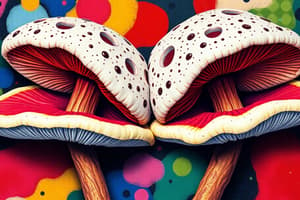Podcast
Questions and Answers
What is the primary purpose of reproduction for species?
What is the primary purpose of reproduction for species?
- To ensure species survival (correct)
- To enhance individual lifespan
- To create genetic defects
- To eliminate weaker individuals
Why is sexual reproduction considered advantageous for species?
Why is sexual reproduction considered advantageous for species?
- It produces identical offspring
- It decreases genetic diversity
- It allows for the creation of new variants (correct)
- It guarantees survival of all offspring
What does extinction refer to in the context of organisms?
What does extinction refer to in the context of organisms?
- The end of a species due to individual deaths (correct)
- A process contributing to species longevity
- The integral survival of organisms over time
- The survival of species through reproduction
How does sexual reproduction enhance survival advantages for species?
How does sexual reproduction enhance survival advantages for species?
Which chapter discusses human reproduction?
Which chapter discusses human reproduction?
What is the significance of molecular basis of inheritance?
What is the significance of molecular basis of inheritance?
Which unit covers the topic of biodiversity and conservation?
Which unit covers the topic of biodiversity and conservation?
How do anthropogenic factors relate to extinction?
How do anthropogenic factors relate to extinction?
What is the primary focus of the discussed unit?
What is the primary focus of the discussed unit?
Who inspired Panchanan Maheshwari to develop an interest in botany?
Who inspired Panchanan Maheshwari to develop an interest in botany?
What significant department did Panchanan Maheshwari establish?
What significant department did Panchanan Maheshwari establish?
Which technique, associated with Panchanan Maheshwari, became a landmark in science?
Which technique, associated with Panchanan Maheshwari, became a landmark in science?
What area did Panchanan Maheshwari focus on in his research?
What area did Panchanan Maheshwari focus on in his research?
What was one of Panchanan Maheshwari's contributions to reproductive health?
What was one of Panchanan Maheshwari's contributions to reproductive health?
What process did Panchanan Maheshwari emphasize the need for initiating?
What process did Panchanan Maheshwari emphasize the need for initiating?
What is one primary issue addressed regarding reproductive health?
What is one primary issue addressed regarding reproductive health?
What does the life span of an organism refer to?
What does the life span of an organism refer to?
Which organism type is noted as having no natural death?
Which organism type is noted as having no natural death?
What is stated about the life spans of organisms in relation to their sizes?
What is stated about the life spans of organisms in relation to their sizes?
Which of the following trees is mentioned as having a shorter life span?
Which of the following trees is mentioned as having a shorter life span?
What signifies the life spans of most organisms?
What signifies the life spans of most organisms?
What was one of the significant contributions related to school education mentioned?
What was one of the significant contributions related to school education mentioned?
What is true about the misconception regarding life span and size?
What is true about the misconception regarding life span and size?
What type of reproduction is mentioned in the content?
What type of reproduction is mentioned in the content?
What type of reproduction do most single-celled organisms like Amoeba and Paramecium use?
What type of reproduction do most single-celled organisms like Amoeba and Paramecium use?
What are zoospores primarily known for?
What are zoospores primarily known for?
In yeast reproduction, how does the cell division occur?
In yeast reproduction, how does the cell division occur?
Which of the following is NOT an asexual reproductive structure?
Which of the following is NOT an asexual reproductive structure?
What happens to the small buds produced by yeast cells after they form?
What happens to the small buds produced by yeast cells after they form?
Which organism is known to use conidia for reproduction?
Which organism is known to use conidia for reproduction?
What is one of the challenges addressed in understanding the reproductive cycles of animals?
What is one of the challenges addressed in understanding the reproductive cycles of animals?
How often does the plant species Mobilattus laura flower?
How often does the plant species Mobilattus laura flower?
What term describes the cyclical changes in non-primates during reproduction?
What term describes the cyclical changes in non-primates during reproduction?
In sexual reproduction, what is the male gamete called?
In sexual reproduction, what is the male gamete called?
What is the chromosome number represented in diploid form (2n) for humans?
What is the chromosome number represented in diploid form (2n) for humans?
Which of the following does NOT occur during fertilization?
Which of the following does NOT occur during fertilization?
What type of reproduction involves the fusion of gametes from two different individuals?
What type of reproduction involves the fusion of gametes from two different individuals?
In plants, what is a characteristic of bisexual organisms?
In plants, what is a characteristic of bisexual organisms?
What defines a dioecious plant?
What defines a dioecious plant?
Which of the following processes occurs post-fertilization?
Which of the following processes occurs post-fertilization?
Flashcards are hidden until you start studying
Study Notes
Reproduction in Organisms
- Each organism has a finite lifespan, ranging from a few days to thousands of years.
- Life span is not correlated with size.
- All individual organisms die, except single-celled organisms.
- Single-celled organisms reproduce through cell division, which is considered a mode of reproduction.
- Binary fission: A single- celled organism divides into two daughter cells. Examples: Amoeba, Paramecium
- Budding: Unequal division of a parent cell, creating a smaller bud that eventually separates to form a new organism. Example: Yeast
- Spore formation: Asexual reproduction in fungi and algae. Spores are usually microscopic and motile, such as zoospores.
- Vegetative propagation: Asexual reproduction in plants, using specialized structures like bulbs (onion), tubers( potato) or rhizomes( ginger).
- The reproductive phase is the period when an organism is capable of producing offspring. It can be of fixed or variable duration.
- Some organisms, such as flowering plants, exhibit a seasonal reproductive phase. Animals in captivity can be induced to reproduce year round.
- In mammals, this phase is characterized by cyclical changes in the activity of ovaries and accessory ducts, known as the oestrous cycle in non-primates and the menstrual cycle in primates.
- Reproduction is a vital process that ensures the continuation of species.
- There are two modes of reproduction: sexual and asexual.
Sexual Reproduction
- Sexual reproduction involves the fusion of gametes from two different individuals.
- Gametes are specialized sex cells that contain half the number of chromosomes of the organism.
- In animals, gametes are usually male sperm (antherozoid) and female egg (ovum).
- Sexual reproduction results in greater genetic variation among offspring, which increases the chances of survival in changing environments.
Asexual Reproduction
- It involves a single parent producing offspring genetically identical to itself.
- Asexual reproduction results in rapid population growth in favorable environments.
- It is advantageous in stable environments where there is little need for genetic variation.
- Asexual reproduction does not involve the fusion of gametes.
- There are several methods:
- Binary fission: A single-celled organism divides into two halves and each rapidly grows into an adult (e.g., Amoeba, Paramecium)
- Budding: A small outgrowth or bud develops on the parent organism, which eventually detaches to form a new organism (e.g., Hydra)
- Spore formation: Specialized reproductive cells, spores are released from the parent and develop into new organisms (e.g., fungi)
- Vegetative propagation: New plants are produced from vegetative parts such as stems, roots, or leaves (e.g., ginger, potatoes)
Importance of Reproduction
- Continuation of species: Reproduction ensures the survival of species.
- Genetic diversity: Sexual reproduction leads to greater genetic diversity in offspring, increasing the chances of survival in changing environments.
- Population growth: Asexual reproduction allows for rapid population growth in stable environments.
Differences Between Sexual and Asexual Reproduction
- Number of parents: Sexual reproduction requires two parents, while asexual reproduction requires only one parent.
- Gamete fusion: Sexual reproduction involves the fusion of gametes, while asexual reproduction does not.
- Genetic variation: Sexual reproduction leads to greater genetic variation in offspring, while asexual reproduction produces offspring that are genetically identical to the parent.
- Environmental conditions: Sexual reproduction is more advantageous in changing environments, while asexual reproduction is advantageous in stable environments.
Studying That Suits You
Use AI to generate personalized quizzes and flashcards to suit your learning preferences.





